Categories
Latest Updates
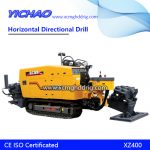
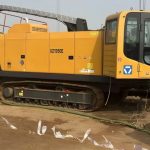
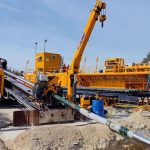
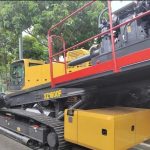
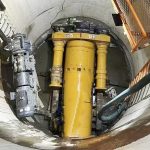
This project is a natural gas pipeline network project supporting the Jiangsu Huadian Yizheng Gas Turbine Cogeneration Project. The total length of the pipeline is about 5.5km, the design scale is 900 million Nm3 / y, the pipeline pressure level is GA1, the design pressure is 6.3 Mpa, and the natural gas delivery pressure is 5.0- 6.3 Mpa, cross gas temperature is 10-20 ℃, natural gas water dew point -10 ℃, hydrocarbon dew point <-40 ℃, pipe diameter D406.4 * 9.5mm, material X60, 3PE reinforced outer anticorrosive layer with straight seam buried on both sides Arc welded steel pipe.
The natural gas pipeline is laid out from the Qingshan sub-transmission station to the west of the Yanjiang high-grade highway, and then passes through the No. 6 road, then crosses the Yanjiang high-grade highway, and then runs along the north side of the Yanjiang high-grade highway and runs parallel to the west-east gas pipeline, Lay through Jingsi and Jingsan Roads to the east of Jinger Road and lay north to Weier Road, along the northern side of Weier Road, lay the south gate to the east on the south side of Yizheng Hua Power Plant District, and along the west side of the factory road to Weisan Road, along the south side of Weisan Road to the east to the interface of the pressure measuring station.
The site is located in the Jiangdu uplift belt, and the bank of the Yangtze River in the middle of the Yizheng Depression. Due to the multiple down-cuts and swings of the main channel of the Yangtze River since the Quaternary, the erosion and weathering of the strata along the coast near the river are strongly reflected in modern strata. The characteristics are that part of the Tertiary strata and all of the Pleistocene Pleistocene strata are missing, and the lithology of the alluvial and alluvial strata changes drastically, and the bedrock surface fluctuates greatly. From the surface to the bedrock, the Quaternary alluvial and alluvial alluviums. According to the drilling revealed, the main strata within the field survey depth are the miscellaneous fills, alluvial and alluvial silty clays, pebble, and sandy mudstones of the Upper Cretaceous formed from the accumulation of the Quaternary Holocene. The classification standard and its mechanical properties are divided into five layers from top to bottom as follows:
① Miscellaneous filling soil: mainly grayish yellow, wet, cohesive soil, containing about 15% silt, with gravel and broken bricks partially. The distribution inside the site was uneven, and part of the drilled surface was exposed.
② silty clay: grayish yellow, plastic, containing brown iron manganese oxide, local powder content is relatively high, slightly shiny, medium stiffness and toughness. The field is widely distributed and most of the drill holes have been exposed.
②1 silt: gray to gray-yellow, very wet, slightly dense, with a high content of local clay particles, with a thin layer of silty clay. The distribution within the field was discontinuous, and some of the boreholes were exposed.
③ Pebble: off-white, compact, with a diameter of 2-7cm, it is sub-circular and prismatic, with a content of about 55%. The gap filling is cohesive soil and gravel. The distribution within the field was discontinuous, and some of the boreholes were exposed.
④ Sandy mudstone: reddish-brown, argillaceous structure, massive structure, irregular development of local weathering cracks, strong weathering to weak weathering. The area is widely distributed and has not been revealed.
According to the pipeline direction of the design document, hills, highways, rivers, embankments and village roads need to be passed along the way. It should be noted that the landform types of Yizheng City are plain area, gang area and hilly area. Although this project is only 5.5km, there are three areas. For the laying of pipelines in Ganggang and hilly areas, it is quite difficult due to the poor terrain and complex geological conditions.
Therefore, the problems caused by conventional excavation and laying are: 1) large amount of earthwork excavated and long construction period; 2) high-grade highways along the river are not allowed to be excavated or broken in principle; 3) The construction of dams, diversion channels, etc., has a large amount of excavation works for river ponds, and the procedures for approval of water conservancy are cumbersome, affecting the construction period; 4) The excavation of village roads will seriously disturb the people.
To solve these problems, there are only two ways: First, the construction cost and construction period of the bypass excavation will more than double. 2. Non-excavation construction, that is, directional crossing construction, allows the pipeline to pass directly according to the planned and designed lines.
The so-called directional crossing construction refers to the use of mechanical methods to control the direction when the operator is unable to enter the work area for excavation and advancing, complete the reaming while drilling, discharging, and removing slag, and directly pass the pipeline to the underground. Construction method. (The installation and construction of pipelines shall be carried out in strict accordance with the corresponding specifications.)
The non-excavation laying (directional crossing) construction scheme proposed by our project department has been repeatedly demonstrated and approved by the owner, design, and supervision. Directional drilling is used for construction across 5 lines, respectively: 1) Weer Road and Hilly Section K0 + 619— K0 + 969, 350 meters; 2) River banks and roads in Yuejin Village K3 + 250—K3 + 700, 450 meters; 3) Newly excavated river channels K4 + 100—K4 + 350, 250 meters; 4) 4 holes drilled into the village Roads K4 + 850—K5 + 150, 450 meters; 5) Longyi Road, brick and tile factory K5 + 230—K5 + 700, 250 meters. A total of 1750 meters, accounting for 30% of the entire line.
3.1 Technical characteristics of directional crossing
3.1.1 Directional drilling through construction includes pilot holes, pre-reamed holes and towed pipelines.
3.1.2 A guide hole is a hole drilled along a predetermined section in a horizontal direction at a predetermined angle, and includes a straight oblique line and a large radius arc.
3.1.3 After the guide hole is completed, the hole must be enlarged to a suitable diameter to facilitate the installation of the finished pipeline. This process is called pre-expanding, and the number of reaming is determined according to the final hole size.
3.1.4 After the pre-reaming is completed, the finished pipeline can be dragged into the drilling.
3.2 Advanced nature of directional crossing
3.2.1 Ground excavation area is greatly reduced. Take the 450m pipeline laying of this project as an example: the excavation covers an area of 15m × 450m = 6750㎡ (15m is the width of the operating zone specified in the design document); the directional crossing covers an area of 900㎡ for the entry point and 400㎡ for the unearth point, for a total of 1300 ㎡ is only one fifth of the excavation construction. The total directional crossing of this project is 1750m, which can reduce the area: 15m × 1750m- (900 + 400) × 4 = 21050㎡
3.2.2 Directional drilling through construction will not hinder traffic, will not damage green areas, vegetation, and will not affect the normal life and work order of shops, hospitals, schools, and residents. It will solve the interference of traditional excavation construction on residents’ lives and traffic. , Damage to the environment and surrounding building foundations and adverse effects.
3.2.3 The modern crossing equipment has high crossing accuracy, easy to adjust the laying direction and burial depth, and the pipeline arc laying distance is long, which can fully meet the design requirements burial depth, and can make the pipeline bypass the underground obstacles.
3.2.4 The buried depth of urban pipe network is generally less than 3m. When crossing rivers, the buried depth is generally 9-18m below the riverbed. Therefore, horizontal directional drilling rigs have no impact on the surrounding environment, do not damage the landform and environment, and adapt to environmental protection. Item requirements.
3.2.5 When directional drilling rigs are used for construction, there is no water or underwater operation, it will not affect the navigation of the river, and it will not damage the dams and riverbed structures on both sides of the river. The construction is not restricted by the seasons. It has a short construction cycle, fewer personnel, and a high success rate. Construction safety Reliable and so on.
3.2.6 Compared with other construction methods, the speed of entering and exiting the site is fast, and the construction site can be flexibly adjusted, especially in urban construction, it can fully show its superiority, and the construction cost is low, and the construction speed is fast;
3.2.7 When large rivers pass through, because the pipeline is buried 9-18mm below the ground, there is little oxygen and other corrosive substances inside the ground, so it plays a role of natural anticorrosion and thermal insulation, which can ensure that the pipeline runs longer.
